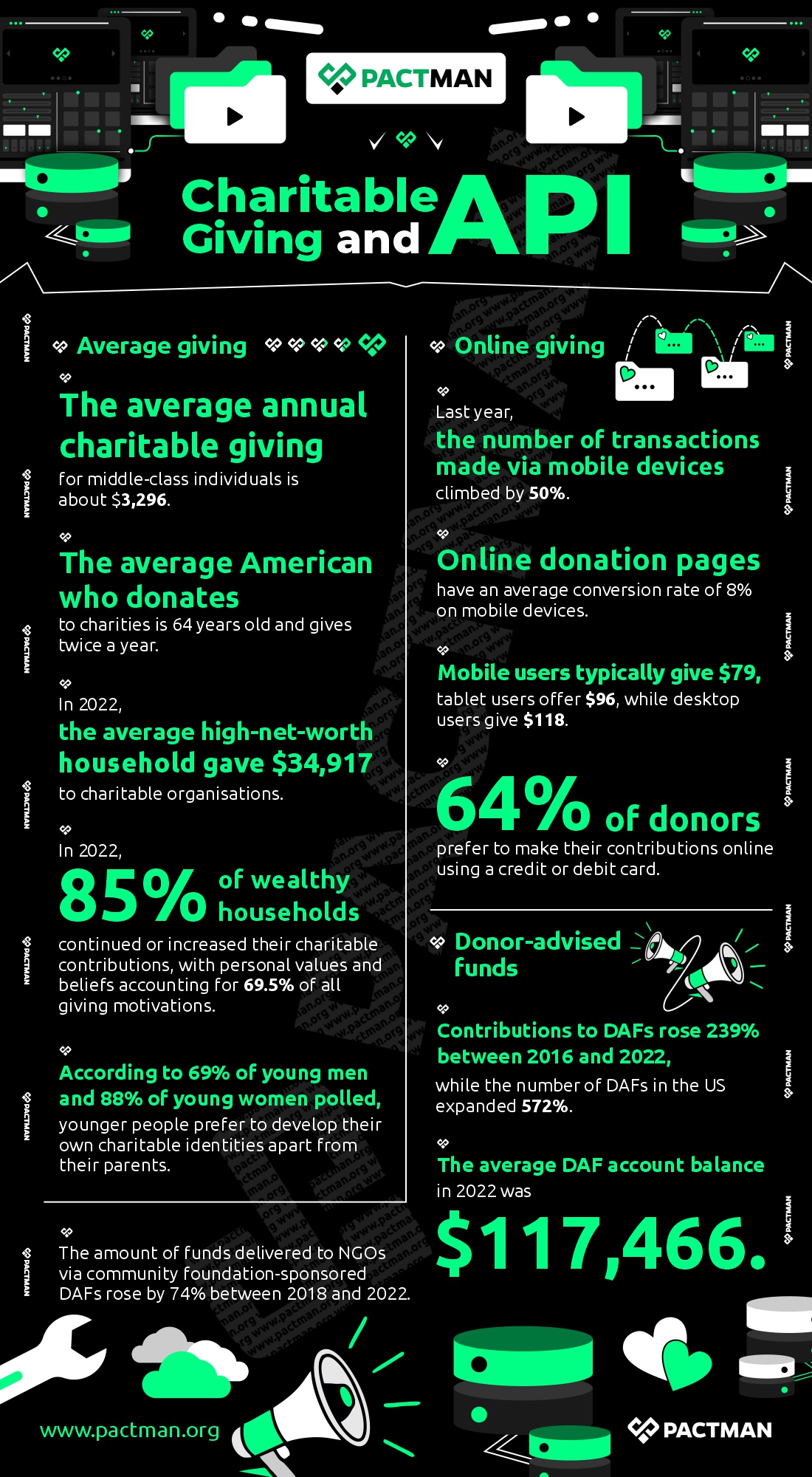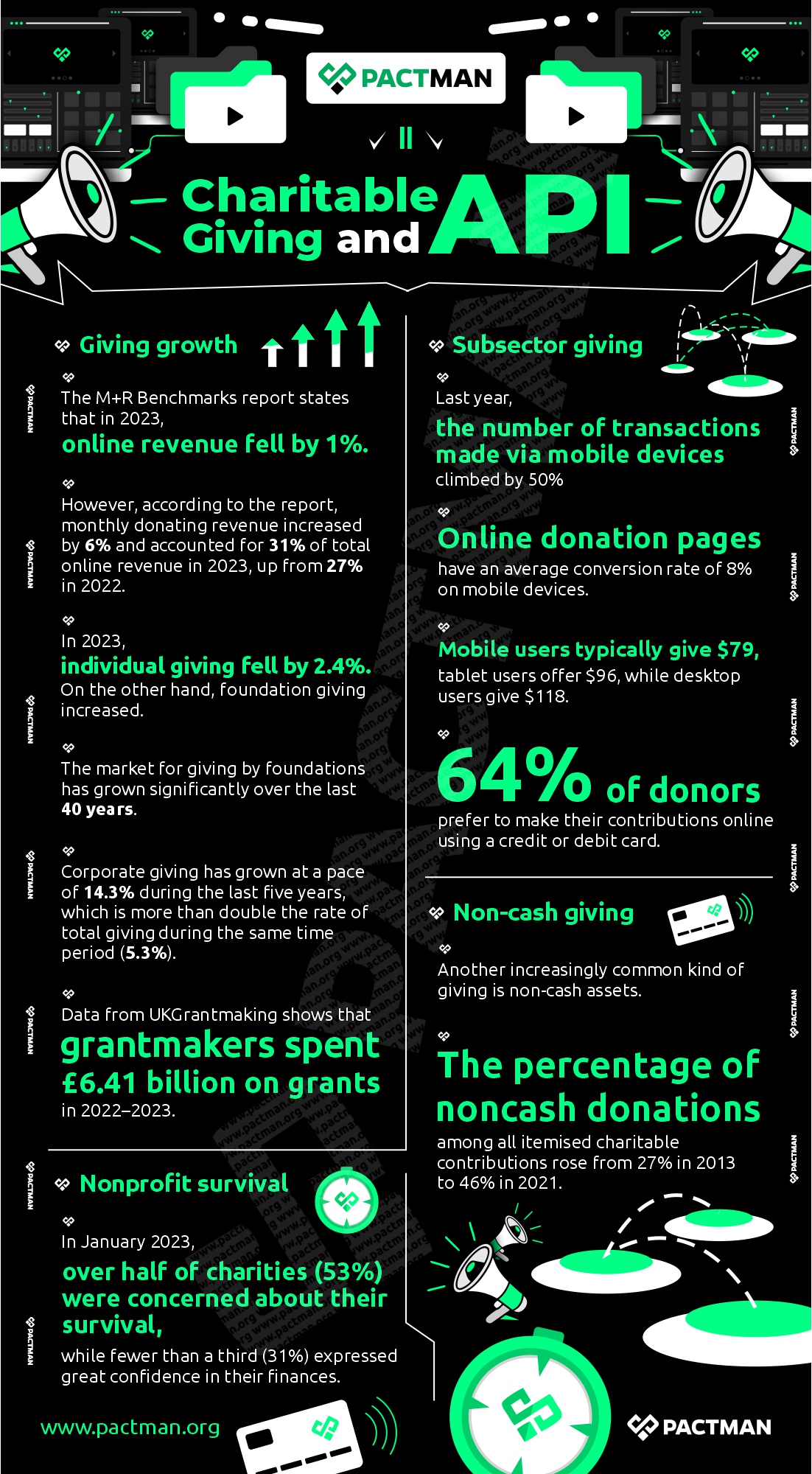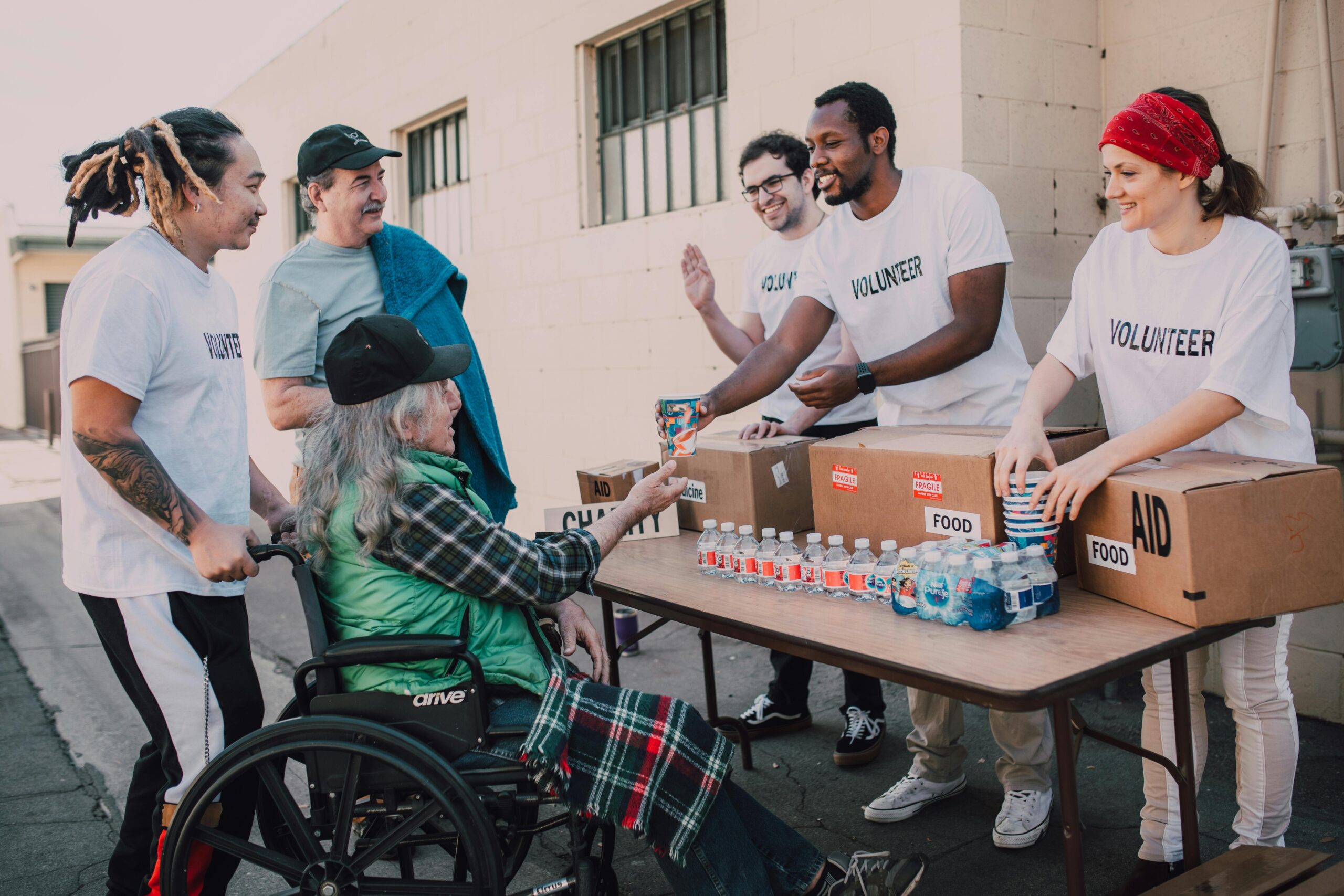I
Introduction
A digital revolution is taking place in charitable giving. Although human connection has always been the foundation of philanthropy, technology, in particular Application Programming Interfaces (APIs), has started to rethink the ways in which giving is scaled, monitored, and mobilised. Now more than ever, the philanthropic infrastructure is changing as a result of APIs.

In 2023, charity donations totaled more than $557 billion in the US, with over 32% of transactions made through digital channels. At the heart of this upsurge are APIs, which assist donors and organisations in bridging the gap between impact and intent. Also, nonprofits and donors are learning that APIs are not only technological enablers but also strategic tools that can improve trust, agility, and transparency as giving behavior becomes more and more data-driven.
Although APIs are frequently linked to fintech, healthcare, or logistics, their influence on nonprofit systems—especially in the area of charitable giving continues to grow significantly. This guide examines the crucial role that APIs play in charitable giving, how donors and NGOs may use them to make a difference, and what innovative organisations are doing. By and large, the goal is to scale the impact of the nonprofit sector by emphasising the need for revolutionary technology.
II
Understanding Charitable Giving and the Role of Donors
Fundamentally, charitable giving is the voluntary transfer of resources, whether monetary or not, from people, foundations, or institutions to nonprofit organisations. Without a doubt, this legislation establishes the social capital of contemporary economies. In addition, it helps promote humanitarian, educational, and social change.

As we all know, giving is an emotional choice supported by the reasonable hope that the resources donated will have a quantifiable impact. The many different types of donors that exist today include decentralised autonomous organisations (DAOs), foundations, corporate entities, donor-advised funds (DAFs), and individuals. In the past, donor interaction was centered on static procedures like manual reporting, paper receipts, and annual campaigns. However, today’s donors anticipate dynamic, real-time engagement. Such a change in behavior highlights an important realisation: The future of giving is not just digital, but programmable.
Also, increased demand creates the conditions for the adoption of APIs. In whatever shape they take, donors look for three things:
- Transparency: Where is the money going?
- Accountability: Does the organisation fulfil its objectives?
- Efficiency: Do donations get handled swiftly and securely?
Also, charitable giving types include:
- Individual Contributions: Gifts of cash, promises, or ongoing payments.
- Corporate Giving: Employee matching schemes, grants, and sponsorships
- Foundation grant: Institutional financing via private, family, or community foundations.
- In-Kind Giving: Contributions of products, labour, or services
As donors become more and more digitally savvy, nonprofits need to adapt by developing platforms and processes that are as responsive as e-commerce or fintech settings. This is where APIs come into play.
III
Critical Statistics on Charitable Giving
This section highlights critical statistics on the impact of charitable giving and how it shapes the sector.
a. Average giving
The average annual charitable giving for middle-class individuals is about $3,296. Also, the average American who donates to charities is 64 years old and gives twice a year. In 2022, the average high-net-worth household donated $34,917 to nonprofits.
Likewise, in 2022, 85% of wealthy households increased their giving, with personal values and beliefs as the motivation for 69.5% of all giving. According to 69% of young men and 88% of young women polled, younger people prefer to develop their own charitable identities apart from their parents.

2. Giving growth
The M+R Benchmarks report states that in 2023, online revenue fell by 1%. However, according to the report, monthly donating revenue rose to 6% and made up 31% of total online revenue in 2023, up from 27% in 2022.
In 2023, individual giving fell by 2.4%. On the other hand, foundation giving increased. The market for giving by foundations has grown significantly over the last 40 years. Corporate giving has grown at a pace of 14.3% during the last five years, which is more than double the rate of total giving during the same time period (5.3%).
UKGrantmaking data shows that in 2022–2023, grantmakers spent £6.41 billion on grants.
3. Nonprofit survival
In January 2023, over half of charities (53%) were concerned about their survival, while fewer than a third (31%) expressed great confidence in their finances.

4. Donor-advised funds
Contributions to DAFs rose 239% between 2016 and 2022, while the number of DAFs in the US expanded 572%. In 2022, the average DAF account balance was $117,466. Additionally, the amount of funds delivered to NGOs via community foundation-sponsored DAFs rose by 74% between 2018 and 2022.
5. Non-cash giving
Another increasingly common giving type is non-cash assets. The percentage of noncash donations among all itemised charitable contributions rose from 27% in 2013 to 46% in 2021.
6. Online giving
Last year, the number of transactions made via mobile devices climbed by 50%. On average, online donation pages have an 8% conversion rate on mobile devices. Overall, mobile users typically give $79, tablet users offer $96, while desktop users give $118.
Also, 64% of donors prefer to make their contributions online using a credit or debit card.
7. Subsector giving
6 out of 10 organisations have seen an increase in donations. In 2023, environmental nonprofits (+3.8%), animal welfare organisations (+1.4%), and medical research (+1.3%) were the top three subsectors with the most growth in charitable contributions.
IV
The Impact of Nonprofit APIs on Charitable Giving
To begin with, Nonprofit APIs serve as a link between the various players in the giving ecosystem, including platforms, grantmakers, donors, regulators, and NGOs. Scalable automation and trust are made possible by their real-time exposure of vital NGO data to external systems. By and large, APIs are influential in six main areas:

1. Donor Verification and Compliance
APIs linked to databases like the OFAC sanctions list, IRS Pub 78, and the IRS Business Master File (BMF) guarantee that funders only contribute to lawful, tax-exempt organisations. Essentially, these APIs facilitate fraud prevention and regulatory compliance by automating due diligence that would otherwise need manual inspection.
2. Seamless Payment Processing
Secondly, APIs integrate with payment gateways such as Stripe, PayPal, and ACH processors to make donations safe and legal. At the API layer, they facilitate real-time tax receipts, donor data reconciliation, and recurring donations.
3. Tailored Donor Experiences
Also, nonprofits can track giving behavior, segment audiences for focused appeals, and tailor information by connecting donor CRM APIs. Predictive analytics is also made possible by behavioral APIs, which help to maximise retention and discover high-value donations.
4. Audit Readiness and Automated Reporting
APIs make it easier to report to internal auditors, donors, and authorities. Every transaction is traceable, auditable, and compliant thanks to data pipelines that connect donor platforms to financial systems and audit logs.
5. Fund Administration and Grant Disbursement
Furthermore, grants can be distributed automatically by foundations and charitable platforms via APIs. Human mistake and administrative slowness can be eliminated by directly embedding eligibility conditions, fund availability, and reporting requirements into the API.
6. Increased Customisation and Donor Engagement
Lastly, data enrichment technologies supported by nonprofit APIs can segment donors according to their behavior, preferences, and giving history. By automating thank-you cards, recommending causes, and customising communications, organisations may increase donor loyalty.
V
How APIs Can Be Used by Organisations and Donors to Give
APIs are strategic levers for gaining a competitive edge in the nonprofit industry, not just backend tools. Also, APIs’ usefulness is not limited to huge organisations. Individual donations and small NGOs can also benefit from them if they have a well-defined plan.

Here are some effective ways different actors can reach their full potential with nonprofit APIs:
For Donors
a. Due Diligence Before Giving
APIs make it possible for donors to quickly confirm an organisation’s legal standing, tax-exempt status, and mission alignment. In order to enable donors to make well-informed selections, tools such as the Pactman Nonprofit Checkplus API combine regulatory data from the IRS and OFAC lists. Also, to ensure tax-deductible eligibility, nonprofit verification APIs can verify 501(c)(3) status and alignment with IRS Pub 78 in real-time.
b. Recurring contribution
Also, APIs can be connected to digital wallets or bank APIs to automate monthly donating. Giving can now be automated without the need for monthly reminders.
- Impact Tracking: Get updates, stories, and KPIs in real time by integrating with impact-reporting APIs and nonprofit CRM.
c. Donor Dashboards
APIs provide information to interactive dashboards that provide tax deductions, impact metrics, and donation history, increasing openness and retention.
For nonprofit organisations
a. Simplified Reporting and Compliance
Nonprofits may automate grant eligibility checks, make reports that satisfy donor and regulatory requirements, and keep current records by integrating with audit and compliance APIs.
b. Multichannel Fundraising
APIs enable NGOs to incorporate donating features into websites, mobile applications, crowdfunding tools, and social media platforms, thereby increasing donor touchpoints and reach. Also, nonprofits can create complex donor journeys by segmenting campaigns based on donor type, scheduling requests around life events, and testing engagement strategies. This is through the use of APIs that link CRM, fundraising, and analytics technologies.
c. Donor Experience Optimisation
Utilise behavioral APIs to tailor appeals and landing pages according to visitor history and donation trends.
d. Operational Efficiency
To lessen the strain of reconciliation, APIs can connect accounting systems, CRMs, and donation platforms.
e. Embedded Philanthropy
Also, Giving APIs can be integrated with fintechs and e-commerce platforms to enable consumers to round up purchases or make donations at the point of sale.
f. Custom Dashboards
Lastly, leverage APIs that show stakeholders fund disbursement, impact metrics, and donation flows.
VI
Key Developments and Applications of API-Powered Charitable Giving
In this section, we will consider how businesses, foundations and organisations are adopting APIs to improve charitable giving.

1. Integrated Charity in Financial Products
Fintech firms are integrating donation options into wallets and investment platforms. For instance, Daffy (Donor-Advised Fund for You), employs APIs to enable users to invest their balances. Users can also create automatic weekly or monthly donation objectives, and make donations straight from the app.
Daffy was founded a little more than three years ago with the straightforward goal of encouraging people to give more frequently. Presently, the platform has established itself as the standard bearer for introducing innovative features to the antiquated industry. Not to mention, they have extended the reach of donor-advised funds as a giving instrument beyond the ultra-wealthy. In 2024, transfers from other DAF providers accounted for 24% of all donations to Daffy, which draws members with accounts ranging in size from hundreds to millions.
Furthemore, real-time round-up purchases or a percentage of profits can be donated by customers and merchants using APIs integrated into platforms like Shopify and Stripe Climate. Through this seamless process, passive consumers become micro-donors.
2. Programmable Grantmaking through APIs
Using grant APIs, Google.org and the Chan Zuckerberg Initiative allocate funds to verified nonprofits that meet predetermined standards. This makes it possible for scalable philanthropy and emergency relief funding to be sent more quickly. Also, the sophisticated, data-driven solution offered by Pactman maximises nonprofit verification, ensures compliance with IRS and regulatory requirements, and speeds up grant-making decisions.
Donors can make gifts with the knowledge that the organisations they support comply with ethical and legal standards by using Pactman Nonprofit Checkplus API. Also, organisations can use Pactman’s API to quickly make educated decisions as it provides instant access to important financial and compliance data.
For instance, the API compiles information from the IRS Automatic Revocation List, OFAC, and IRS BMF to guarantee compliance for financial institutions, grantors, and donor-advised funds. This saves hours of manual screening while lowering the risk of financial and reputational exposure.
3. Marketplace Giving Platforms
Thirdly, APIs enable thousands of NGOs to list, take gifts, and issue receipts without the need for custom coding. Examples of these platforms are Benevity, JustGiving, and Give Lively. These marketplaces frequently combine information from several APIs (Stripe, OFAC, IRS, etc.).
Also, Charity Navigator and GiveWell provides nonprofit ratings and impact indicators using APIs. This helps increase donor trust and makes nonprofit performance data more accessible to all. Another nonprofit, Charity: Water connects every donation to a particular project and community by delivering donor-specific narrative through API interfaces with Segment and Mailchimp.
4. Web3 Integration and Decentralised Donations
New APIs facilitate NFT-based contributions and cryptocurrency philanthropy. For example, to appeal to a younger, tech-savvy audience, emerging platforms such as Giveth and The Giving Block are developing APIs on top of blockchain infrastructure to produce tokenised donor recognition and tamper-proof donation flows. The Giving Block incorporates APIs for nonprofit verification, tax compliance, and real-time cryptocurrency valuation.
5. Automation of Corporate Social Responsibility (CSR)
Also, businesses are using APIs to automate volunteer monitoring and matching gift programs. For example, YourCause by Blackbaud enables automatic matching and impact reporting by connecting business systems with verified nonprofit databases via APIs. Benevity, which is trusted by Google, Nike, and SAP, employs a set of APIs to manage corporate giving programs, interact with HR systems, and produce ESG reports in real time.
Through its API, GlobalGiving enables partner platforms to distribute donations in more than 170 nations. Thematic areas (such as education and climate change) can be selected by donors, and funding can be distributed by algorithms.
6. Compliance Tools Driven by APIs
Lastly, nonprofit platforms such as Pactman Nonprofit Checkplus API offer audit data storage via API, IRS and OFAC checks, and mass verification. This makes nonprofit status checks almost immediate, which streamlines the donor onboarding process for fundraising platforms and grantmakers.
As can be seen, a revolution in data and technology is only getting started in the nonprofit sector. APIs are becoming fundamental and not optional. Now more than ever, nonprofits can adopt APIs to:
- Increase giving channels and audiences by implementing integrated philanthropy.
- Ensure automation and integration to cut operating expenses.
- Assure real-time audit preparedness and regulatory compliance.
- Gain insights from data to improve impact measurement and fundraising.
Without a doubt, donor-centric, data-enabled, and API-first charity giving will be the norm in the future. Organisations who choose to invest in API strategy now will be the ones that prosper in the future.
Conclusion
The purpose of APIs is not only to facilitate connectivity, but to enhance generosity at scale. Likewise, checks, fancy dinners, and year-end appeals are no longer the only ways that people can give to charities. Hence, nonprofits must reinvent themselves as API-powered organisations that are adaptable, transparent, and impact-driven as giving becomes more digital.
The current environment is data-rich, compliance-driven, and powered by APIs, and it requires the same strategic architecture as commercial businesses. Even more, nonprofits and donors both win from this environment: nonprofits expand their operations while upholding regulatory integrity, while donors acquire trust and real-time impact information.
APIs will play a crucial role in ensuring that giving is translated into quantifiable good in a timely, accurate, and transparent manner as they become the backbone of nonprofit ecosystems. Whether you’re a nonprofit looking to scale impact or a donor looking for more intelligent giving options, the time to adopt nonprofit APIs is now.
To streamline compliance, expedite fundraising, and boost donor confidence, investigate API alternatives such as the Pactman Nonprofit Checkplus API and begin your impact journey.


